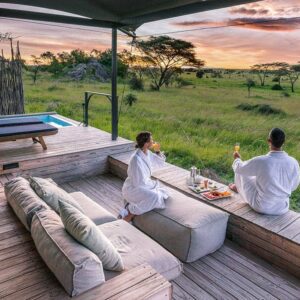Everything You Need to Know About Arusha National Park.
Arusha National Park features diverse landscapes like Mount Meru, the Momella Lakes, and the Ngurdoto Crater, which host abundant wildlife such as giraffes, zebras, and colobus monkeys, along with over 400 bird species. The park is noted for unique safari activities, including walking safaris, canoeing on the lakes, and guided hikes on Mount Meru. While it offers a more intimate wildlife experience, it’s also an ideal starting point for northern circuit safaris and can be conveniently explored as a day trip.
Tucked away in the foothills of Mount Meru, Arusha National Park a captivating and often overlooked gem in Tanzania’s famous northern safari circuit. While it may lack the fame of the Serengeti or the size of other national parks, its diverse landscapes, unique activities, and rich biodiversity offer a truly memorable and intimate safari experience. This article will guide you through everything you need to know to plan your visit, from the best time to go and what you’ll see to essential travel tips.
Overview of Arusha National Park
Arusha National Park a diverse park in northern Tanzania, known for the dominant Mount Meru, Momella Lakes, and Ngurdoto Crater. This park home to numerous species, including giraffes, zebras, elephants, water buffalo, and is the only place in northern Tanzania to easily spot the black-and-white colobus monkey. Activities available include hiking, canoeing, walking safaris, and birdwatching, with the park’s varied habitats ranging from mountain forests to tropical rainforests and volcanic landscapes. Arusha National Park, a relatively small park, covering approximately 137 square kilometers, packs an impressive punch with its stunning and varied topography, the ultimate guide to Arusha National Park. The park is defined by three main features:
Mount Meru: A majestic, dormant volcano and the second-highest peak in Tanzania, offering Arusha National Park Tours challenging treks and breathtaking views.
The Ngurdoto Crater: A lush, swampy caldera often referred to as “Little Ngorongoro,” home to a wide array of wildlife.
The Momella Lakes: A series of seven shallow, alkaline lakes that shimmer with varying hues of green and blue, attracting a spectacular concentration of water birds.
Unlike the vast savannahs of other parks, Arusha offers a unique blend of montane forest, grasslands, and lakes, making it a perfect destination for those seeking a different kind of safari adventure.
Arusha National Park Safari Reviews: A Different Kind of Experience
Safari reviews for Arusha National Park consistently highlight its unique charm and the variety of activities it offers. While it’s not the place to see the Big Five (lion and rhino are absent), visitors rave about the opportunity for walking safaris and canoe safaris, which provide a level of immersion with nature that game drives alone cannot. Experts and travelers alike praise the park’s scenic beauty and the chance to get up close with animals on foot, accompanied by an armed ranger. It is a fantastic destination for a day trip or as a prelude to a longer safari in the region.
Wildlife & Animals in Arusha National Park
While large predators like lions are not a feature of Arusha, the park teeming with a diverse range of animals. It’s particularly famous for having one of the highest concentrations of giraffes in Tanzania, the main Animal of Arusha National Park. You can expect to see large herds of buffalo, zebra, and warthogs grazing on the savannahs, while hippos and various water birds inhabit the Momella Lakes. The forested areas of Mount Meru and the Ngurdoto Crater are where you’ll find the park’s most distinctive residents: the acrobatic black-and-white colobus monkey and the curious blue monkey.
The rarest animals to spot in Arusha National Park, elusive leopard and the rare elephant, though spotting them is challenging due to their camouflage and the park’s thick foliage. While other animals like cheetahs, elephants, and leopards are uncommon in the park compared to other Tanzanian reserves, occasional sightings do occur.
Arusha National Park a Birdwatching Paradise
Arusha National Park a haven for bird watchers, boasting over 400 species. The Momella Lakes are a particular highlight, with thousands of migratory flamingos often gathering to create a stunning pink spectacle. Other notable bird species include various herons, pelicans, African fish eagles, and storks, as well as forest birds like the Hartlaub’s turaco and silvery-cheeked hornbill. This small but varied park provides an excellent opportunity for bird enthusiasts to see a wide range of resident and migratory birds in a stunning setting at the base of Mount Meru
What is the Best Time / Month to Visit Arusha National Park?
The best time to visit Arusha National Park is during the dry season, from June to October, as the vegetation is less dense, making it easier to spot wildlife, and fewer mosquitoes are present. While the dry season is optimal, the wet season, particularly November to December, can also be a good time for scenic views and birdwatching with lower crowds and potential for lower lodge rates, though March to May brings heavy rains. The best time to visit Arusha National Park depends on your priorities.
For wildlife viewing: The dry season, from June to October, is ideal. The vegetation is sparser, and animals congregate around water sources, making them easier to spot.
For birdwatching and scenery: The wet season, from November to May, is excellent. The park is lush and green, and this is when migratory birds, including the flamingos, are most numerous. However, be aware that March and April can be very wet, which might affect road conditions.
For climbing Mount Meru: The dry season, especially from June to March, is the best time for trekking due to clearer skies and better trail conditions.
Weather & Climate Arusha National Park
Arusha National Park has a mild, tropical climate with two dry seasons (June-October, with June–August being the coldest) and two wet seasons (March-May, the long rains, and November-December, the short rains). Daytime temperatures are generally mild, averaging around 19–25°C (66–77°F), while nights and early mornings can be cold, especially in higher areas, dropping to around 9°C (48°F) or even lower. Wildlife viewing is best during the dry season, with clear skies and better visibility, though the scenery is more impressive during the wet season. Arusha National Park enjoys a mild climate, with average daytime temperatures around 21∘°C 70 ∘ 70°F). It can get quite cool in the mornings and evenings, especially during the dry season, so packing layers is essential. The park’s higher elevation keeps humidity levels lower than in other parts of Tanzania.
Getting to Arusha National Park
The Arusha National Park, easily accessible, located just a short 40-minute drive northeast of the city of Arusha, which serves as the hub for all northern Tanzania safaris. The closest international airport is Kilimanjaro International Airport (KIA), which is about 58 km away. Most visitors arrange transportation through their safari operator. By Air: The primary entry point for northern Tanzania, Kilimanjaro International Airport (JRO), located about 50 kilometers from Arusha town. You can also fly to Dar es Salaam and take a domestic flight to Arusha Airport (ARK) or Kilimanjaro International Airport. By Road: You can drive to Arusha from other cities like Nairobi or Dar es Salaam. By Bus: An express coach from Nairobi is another option for reaching Arusha. From Arusha Town/Airport to the Park Taxis or Private Vehicles: Once in Arusha town, Taxis or private vehicles can be hired to take you to the park’s main gate, which is approximately 25 kilometers away.
Malaria & Safety in Arusha National Park
Arusha National Park is a malaria-risk area, so it’s crucial to consult your doctor about taking malaria prophylaxis. Other safety measures include using insect repellent, wearing long-sleeved shirts and trousers in the evenings, and sleeping under a mosquito net. In general, the park is considered a safe destination for tourists.
Map of Arusha National Park
The park its divided into its three distinct geographical features: Mount Meru, the Ngurdoto Crater, and the Momella Lakes. While the crater floor is a protected area, a road runs along the rim, offering spectacular viewpoints. An interactive map would show how these different zones are connected by roads and walking trails. Note: Arusha National Park features three main areas for safaris: Mount Meru, which offers hiking and viewing opportunities on its lower slopes, the Ngurdoto Crater, a forest-rimmed swamp with abundant wildlife viewing from its rim, and the Momella Lakes, a series of alkaline lakes known for birdwatching and large water birds like hippos.
Arusha National Park Accommodations
While some accommodations within the park’s boundaries, such as the Hatari Lodge, many visitors stay in the surrounding areas of Arusha and the Usa River. offering luxury, comfort, and various amenities such as private rooms, dining options, and proximity to park locations like Mount Meru Crater and Momella Lakes. Other options are available in the surrounding areas and the city of Arusha. These lodges and hotels offer a wide range of options, from budget-friendly to luxury, and provide convenient access to the park as well as other attractions.
Safari Packages
Arusha National Park popular choice for a single-day safari top things to do in Arusha National Park often added to the beginning or end of a longer Tanzanian safari itinerary. However, multi-day packages also available, especially for those who wish to combine game drives with a Mount Meru climb or a canoe safari. You can easily find packages that include a walking safari, canoeing on Momella Lakes, and game drives, or you can tailor your own itinerary with a local tour operator.
Packing List for Arusha National Park
A packing list for Arusha National Park should include lightweight, neutral-colored clothing like long-sleeve shirts and pants, a sweater or jacket for cool mornings and evenings, comfortable hiking shoes or boots, and a rain jacket if traveling in the green season. Essential health and safety items are sunscreen, high-SPF lip balm, insect repellent, a small first-aid kit, any personal medications, including anti-malarials, and sunglasses. Don’t forget practical items like a daypack, a wide-brimmed hat, binoculars, a camera, and a headlamp or flashlight.
Clothing: Layered, lightweight, and neutral-colored clothing best. Include long-sleeved shirts and trousers for protection against insects and the sun, a warm fleece or jacket for chilly mornings and evenings, and a wide-brimmed hat.
Footwear: Comfortable closed-toe shoes for game drives and walking, as well as sturdy hiking boots if you plan to climb or do a long walk.
Essentials: Sunscreen, sunglasses, insect repellent, a basic first-aid kit with any personal medications, a camera with extra batteries and memory cards, and a pair of binoculars. Other: A reusable water bottle and a small backpack for day trips.
10 interesting facts about Arusha National Park:
Home to Mount Meru: The park its dominated by Mount Meru, Tanzania’s second-highest mountain and Africa’s fifth-highest, visible throughout the year, according to Adventure Pulse and Easy Travel Tanzania.
World’s Highest Giraffe Population: The park boasts the highest concentration of giraffes in Tanzania, making them easily visible.
Diverse Habitats: Arusha National Park features a rich diversity of landscapes in a relatively small area, including the savannahs, forests, lakes, and the Ngurdoto Crater.
Ngurdoto Crater: Located to the south, this “rabbit hole” is a swampy crater that supports abundant wildlife and can be viewed from its rim.
Momella Lakes: The park’s northeast its home to seven shallow Momella Lakes, famous for attracting a variety of waterfowl and being a feeding ground for unique wading birds.
Abundant Birdlife: With over 400 species, the park its a haven for birdwatchers, with waterfowl like flamingos, pelicans, herons, and eagles readily spotted, especially around the lakes.
Close Proximity to Arusha City: Located a short drive from Arusha town, the park a convenient and accessible destination, perfect for a day trip.
Walking and Canoe Safaris”: Unlike many other parks, Arusha offers opportunities for walking safaris through the plains and forests on the lower slopes of Mount Meru, and canoe safaris on the Momella Lakes.
Colobus Monkeys: This a main attraction for many visitors, who can easily spot the black and white colobus monkeys in the park’s woodlands.
Easy Wildlife Viewing: Despite its small size, the park provides abundant sightings of wildlife such as Cape buffalo, zebras, warthogs, hippos, elephants, and a variety of antelopes.
Arusha National Park FAQs
Arusha National Park closest park to Arusha town, known for walking safaris, diverse wildlife such as giraffes and monkeys, and the central Mount Meru. It features diverse habitats, including Momella Lakes and the Ngurdoto Crater, and offers activities like canoeing. The park is open year-round, with the best wildlife viewing during the dry season (June-October) and the best time for climbing Mount Meru being June to February, though visitors should expect cool mornings and evenings.
Can I see the Big Five in Arusha National Park?
No, you will not see a lion or rhino. However, it’s a great place to see buffalo, elephant (occasionally), and a high concentration of giraffes.
Are walking safaris safe?
Yes, walking safaris are conducted with an armed ranger who is trained to ensure your safety.
How long does it take to climb Mount Meru?
A full climb to the summit typically takes 3-4 days.
Is Arusha National Park a good place for a family safari?
Yes, the park’s diverse activities and proximity to the city of Arusha make it a great option for families.
Is it necessary to book in advance?
It’s always recommended to book your safari and accommodation in advance, especially during peak season, to ensure availability.
Can I see the Big Five in Arusha National Park?
No, you cannot typically see all of the “Big Five” animals (lion, leopard, elephant, rhino, and buffalo) in Arusha National Park, as it not a Big Five destination, although a few of the animals may be present. While the park is home to a diverse range of wildlife, such as giraffes, zebras, buffaloes, and various primates like colobus monkeys, lions, and rhinos are rarely, if ever, spotted, and leopards are also difficult to find. The park is better known for its scenic diversity, including Mount Meru, the Ngurdoto Crater, and the Momella Lakes, and for activities like walking safaris and canoeing.






